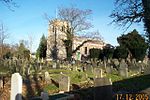Canons Park
Areas of LondonDistricts of the London Borough of HarrowGrade II listed parks and gardens in LondonParks and open spaces in the London Borough of HarrowUse British English from August 2015

Canons Park is a public park and the name of its surrounding residential area, in the Stanmore district of the London Borough of Harrow, north west London. Canons Park was a country estate which partially survives today as a public park. St. Lawrence's Church, the parish church of Little Stanmore, and the accompanying Chandos Mausoleum are located here.
Excerpt from the Wikipedia article Canons Park (License: CC BY-SA 3.0, Authors, Images).Canons Park
Whitchurch Gardens, London
Geographical coordinates (GPS) Address Nearby Places Show on map
Geographical coordinates (GPS)
| Latitude | Longitude |
|---|---|
| N 51.6093 ° | E -0.2884 ° |
Address
Whitchurch Gardens 117
HA8 6PA London (London Borough of Harrow)
England, United Kingdom
Open on Google Maps






